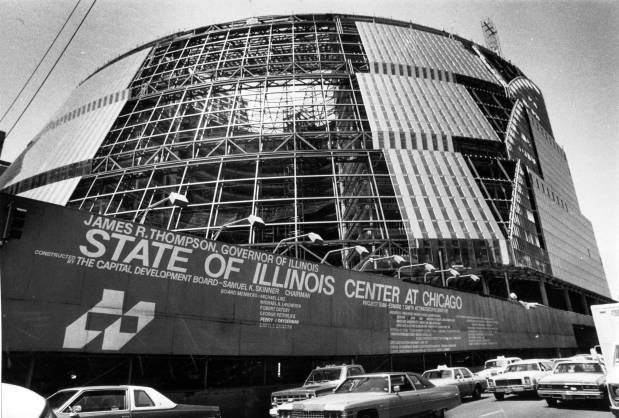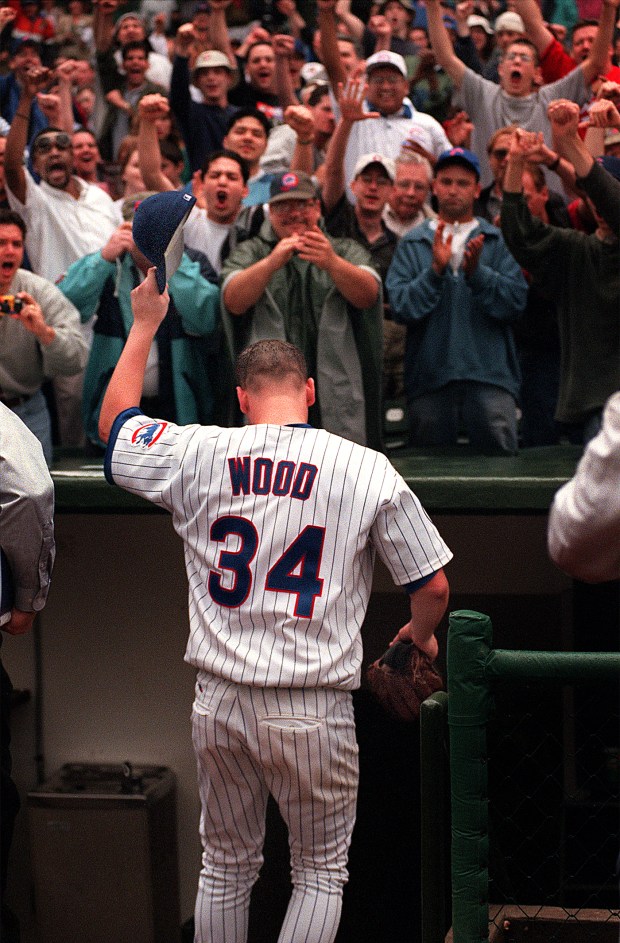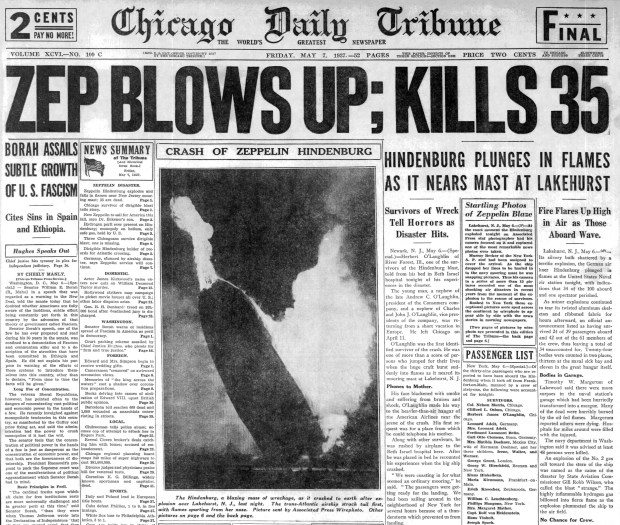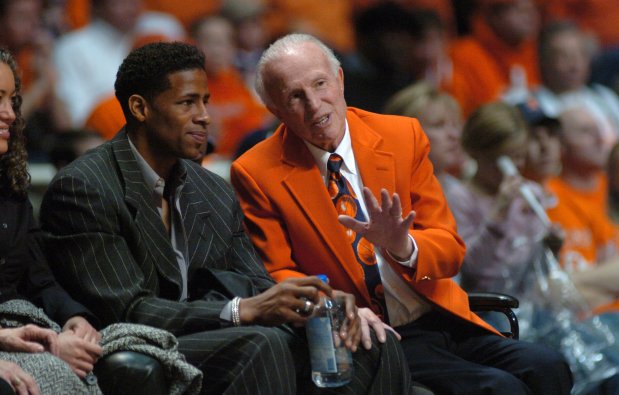Here’s a look back at what happened in the Chicago area on May 6, according to the Tribune’s archives.
Is an important event missing from this date? Email us.
Weather records (from the National Weather Service, Chicago)
- High temperature: 91 degrees (1949)
- Low temperature: 30 degrees (1992)
- Precipitation: 1.41 inches (1941)
- Snowfall: None
1856: D. Harper & Co. proposed to the Chicago City Council construction of an iron bridge at Rush Street for $53,000. It would become the first bridge of its kind in the city and the first of its kind built west of the Allegheny Mountains. The bridge collapsed on Nov. 3, 1863, sending 100 head of cattle and several horse-pulled wagons with drivers into the river. A young girl died.
1937: WLS reporter Herbert Morrison recorded a dramatic, on-the-scene account of the crash of the Hindenburg, a German zeppelin, as it attempted to dock in Lakehurst, New Jersey. The aircraft burned in 34 seconds. Four passengers were men from Chicago; three survived. The 36 who died included 13 passengers, 22 crew members and a sailor on the ground who manned the docking lines.
Millions heard Morrison’s tear-filled account of the explosion, the fire and people falling from the sky. He cried: “Oh, the humanity! … All the passengers … I don’t believe it!”
Vintage Chicago Tribune: 100 years of WLS — the ‘World’s Largest Store’ — radio
Most people assume Morrison’s words were broadcast live, but they were first aired the next day when a recording disc was played. It was played again the following night. Another wrong impression involves Morrison’s voice, which seems excited and high-pitched. But experts believe the recording speed was off, masking the fact that Morrison had a rather low voice.
The Tribune reported later that German employees at the terminal, worried that the disaster would harm the image of Nazi Germany, tried to impound the recording equipment. “I managed to distract them while Charles (Nehlsen, WLS engineer) gathered up the equipment and ran out of the building with it,” Morrison said. “We literally had to hide out until American Airlines could provide us with a plane later that night. We took off for Chicago from a remote corner of the airport.”

1985: The State of Illinois Center was dedicated. The pink-and-blue building with stunning atrium and walls made of glass, was championed by Illinois Gov. James R. Thompson as the catalyst for a revitalization of Chicago’s Loop. Thompson also approved its futuristic design and later the structure was renamed for him.
The center, designed to house thousands of government workers from dozens of agencies, was initially touted as, “A building for the year 2000.” Not long after the dawn of the new millennium, however, cash-strapped state officials began looking for ways to sell it — or demolish it.
Fast forward to May 6, 2024. That’s when a massive transformation of the 39-year-old building began. The renovation has taken the center down to its steel structure, making it temporarily see-through. Google expects to occupy the space next year and plans are to keep its renewed atrium open to the public.

1993: The computerized, driverless Airport Transit System (nicknamed the “People Mover”) — made up of 13 45-foot-long cars in configurations of two or three —opened at O’Hare International Airport. The train connects passengers to each of the airport’s terminals and a transit facility that includes parking, rental cars, Pace bus stops and connects to a Metra station.
A project to update and expand the people mover began in 2015. Construction on the people mover was initially supposed to be substantially complete by December 2018, and service interruptions were supposed to be kept to a minimum during construction. But the project soon devolved into delays, finger-pointing and contract disputes, the Tribune found in a 2019 investigation. The system was completely reopened in April 2022.

1998: On a drizzly day at Wrigley Field, 20-year-old rookie Chicago Cubs pitcher Kerry Wood tied Roger Clemens’ all-time single-game record of 20 strikeouts in a nine-inning game. Wood also had 18 more strikeouts than baserunners allowed, putting him ahead of Clemens in 1986 (20 strikeouts, three baserunners), Clemens in ’96 (20 strikeouts, four baserunners), David Cone in ’91 (19 strikeouts, four baserunners) and Tom Seaver in 1970 (19 strikeouts, four baserunners).
If not for Kevin Orie’s failure to glove a Ricky Gutierrez grounder leading off the third, which was ruled a hit, Wood might have had a no-hitter to boot. In the minds of many observers it was the single greatest pitching performance in baseball history, and certainly one of the most dominant. The Cubs beat the Houston Astros 2-0.
2015: In a dramatic moment, the Chicago City Council rose to acknowledge victims of torture at the hands of former police Cmdr. Jon Burge before they unanimously approved a $5.5 million reparations package.
Want more vintage Chicago?
Subscribe to the free Vintage Chicago Tribune newsletter, join our Chicagoland history Facebook group, stay current with Today in Chicago History and follow us on Instagram for more from Chicago’s past.
Have an idea for Vintage Chicago Tribune? Share it with Kori Rumore and Marianne Mather at krumore@chicagotribune.com and mmather@chicagotribune.com





